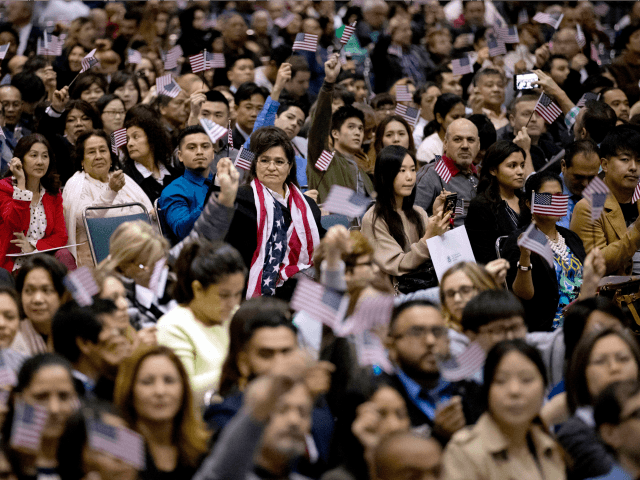Roughly 8.5 million foreigners got green cards during the eight years of former President Barack Obama’s tenure, according to new data from the Department of Homeland Security.
The population of 8.5 million legal immigrants is just short of the estimated nine million young and middle-aged Americans who remain outside the U.S. workforce, according to a December 2017 calculation by one of Obama’s former top economists.
The 8.5 million score, however, is far less than Obama reached for in the 2013 “Gang of Eight” amnesty, which would have given green cards to at least 30 million people in a decade. Obama also tried and failed to pass the DREAM Act amnesty for 3.25 million illegals.
Obama’s annual inflow is lower than the 5.38 million immigrants given green cards by former President George H. W. Bush from 1989 to 1992. That Bush spike followed President Ronald Reagan’s 1986 amnesty, which was much larger than the advocates predicted. Bush’s post-amnesty inflow added up to 1.29 million immigrants per year, compared to Obama’s 1.05 million per year.
In 2016, Obama’s last year, 1.2 million foreigners got green cards. The DHS data says the precise number was 1,183,505. Obama’s green-card numbers include many of the refugees and asylum seekers his deputies welcomed into the United States.
Obama’s annual inflow of legal immigrants was perhaps three times the hidden inflow of illegal immigrants, which was estimated at four hundred thousand in 2016. That estimate is based on the fact that roughly 408,000 migrants were caught at the border in 2016 and sent home.
By subscribing, you agree to our terms of use & privacy policy. You will receive email marketing messages from Breitbart News Network to the email you provide. You may unsubscribe at any time.
The vast majority of the 2016 legal migrants were unskilled and so likely to depend on welfare and government aid throughout their lives. For example, less than 10 percent — or only 115,961 — of the 2016 immigrants claimed to have “management, professional, and related occupations” that pay well enough to require income taxes.
In comparison, 565,255 people claimed “no occupation/not working outside home,” making it unlikely that they will ever pay enough income taxes to offset their gains from welfare.
But even poor immigrants are good for business because they use their aid from taxpayers to buy food, lodging, entertainment, autos and other services or goods from members of the Chamber of Commerce. In Washington, business groups push for a greater inflow of unskilled migrants because their taxpayer-aided consumption — of food, entertainment and much else — helps expand the size of the nation’s economy even as it also reduces average productivity and income.
Chain-migration ensured that Asian migration — at 462,299 — outpaced the flow from Mexico and other Central American countries, which reached 427,293.
In contrast, President Donald Trump is pushing policies that would roughly halve the annual inflow of migrants by ending chain-migration and by emphasizing skilled immigration. That reduced inflow would likely produce salary-gains for Americans and would help sidelined Americans join the workforce.
During the same eight-year period in which 8.5 million foreigners were allowed to immigrate under Obama, roughly 32 million Americans were born, and roughly 32 million turned eighteen.
Each year, 4 million Americans turn 18 and begin looking for good jobs in the free market.
But the federal government inflates the supply of new labor by annually accepting 1 million new legal immigrants, by providing work-permits to roughly 3 million resident foreigners, and by doing little to block the employment of roughly 8 million illegal immigrants.
The Washington-imposed economic policy of mass-immigration floods the market with foreign labor, spikes profits and Wall Street values by cutting salaries for manual and skilled labor offered by blue-collar and white-collar employees. It also drives up real estate prices, widens wealth-gaps, reduces high-tech investment, increases state and local tax burdens, hurts kids’ schools and college education, pushes Americans away from high-tech careers, and sidelines at least 9 million marginalized Americans and their families, including many who are now struggling with opioid addictions.
The cheap-labor policy has also reduced investment and job creation in many interior states because the coastal cities have a surplus of imported labor. For example, almost 27 percent of zip codes in Missouri had fewer jobs or businesses in 2015 than in 2000, according to a new report by the Economic Innovation Group. In Kansas, almost 29 percent of zip codes had fewer jobs and businesses in 2015 compared to 2000, which was a two-decade period of massive cheap-labor immigration.
Because of the successful cheap-labor strategy, wages for men have remained flat since 1973, and a large percentage of the nation’s annual income has shifted to investors and away from employees.

COMMENTS
Please let us know if you're having issues with commenting.